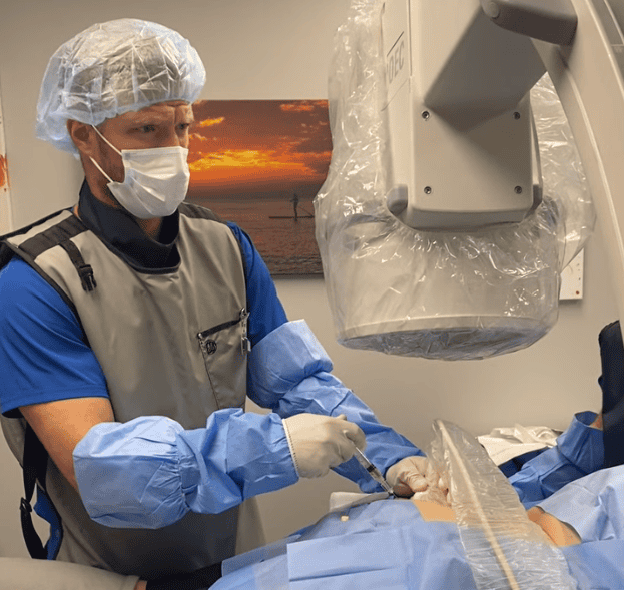Sciatica is a common type of pain involving radiating sensations down the back of the legs. This ailment can significantly impair daily activities and reduce quality of life. Traditional modalities include home exercises, physical therapy, medications, and sometimes surgery. However, in a number of new studies Platelet-Rich Plasma (PRP) injections, have been gaining notoriety for their effectiveness in managing sciatica.
Understanding Sciatica and Disc Herniations
Sciatica refers to pain that travels along the path of the sciatic nerve, which originates from nerves in the lower back that coalesce and travel through the hips, buttocks and down each leg. A common cause of sciatica is a herniated disc, where the soft center of a spinal disc pushes through a tear in the tougher exterior casing and causes irritation of the nerves that form the sciatic nerve. When this happens the patient will often experience shooting pain that radiates towards the hips, buttocks and/or down the leg.
What are PRP Injections?
Platelet-Rich Plasma (PRP) injections are a regenerative option that uses the patient’s own blood platelets to promote healing. Blood is drawn and placed in a centrifuge to separate the plasma, which is rich in platelets and growth factors. These platelets are then concentrated to levels much higher than found in the human body. This PRP is then injected into the affected area, in this case, around the damaged disc or the sciatic nerve using fluoroscopic guidance (live X-ray).

How PRP Injections Work for Sciatica Pain
Recent studies have shown that PRP can be an effective procedure for sciatica pain, particularly when it is caused by disc herniations. Here’s how PRP injections work:
- Reducing Inflammation: PRP contains growth factors that help reduce inflammation. Inflammation around the herniated disc can exacerbate sciatica pain by putting additional pressure on the nerve. By injecting PRP into the affected area, the inflammation is reduced, leading to pain relief.
- Promoting Tissue Repair: The growth factors in PRP aid in the repair of damaged tissues. When a disc herniates, it’s typically a result of tearing in the fibrous annular layer of the disc. PRP helps in the healing of these tears, improving the structural integrity of the disc and reducing nerve compression.
- Regenerating Damaged Nerves: Sciatica pain is often a result of nerve damage or irritation. PRP injections can promote the regeneration of nerve tissues, helping to restore normal nerve function and reduce pain signals.
PRP for Sciatica Studies:
Several studies have demonstrated the effectiveness of PRP in treating sciatica pain from disc herniations. Let’s take a look at two:
- This study compared the efficacy of leucocyte-rich PRP with corticosteroids in treating chronic degenerative spinal pain, which includes sciatica. The study found that PRP was more effective in providing long-term pain relief and improving function compared to corticosteroid injections.
- The Use of Lumbar Epidural Injection of Platelet Lysate for Treatment of Radicular Pain:
- This study focused on the use of lumbar epidural injections of platelet lysate (a derivative of PRP) for radicular pain, which is often caused by disc herniations and results in sciatica. The results indicated significant pain relief and functional improvement in patients treated with platelet lysate compared to baseline measurements.

Benefits of PRP Injections
- Non-Surgical: Unlike surgical interventions, PRP injections are minimally invasive. It involves only needle sticks, which means less risk and a shorter recovery time.
- Natural Procedure: Since PRP uses the patient’s own blood, it reduces the risk of allergic reactions, infections, or other complications.
- Long-Lasting Relief: PRP promotes healing at a cellular level, which can lead to more sustainable and long-term pain relief compared to temporary solutions like medications or epidural steroid injections.
What to Expect During PRP Procedure
The PRP procedure process typically involves:
- Consultation: Our board-certified physicians will evaluate your condition to determine if PRP injections are suitable for you.
- Blood Draw: Blood is drawn out of the patient’s arm, similar to a routine blood test.
- Lab processing: The PRP is isolated and concentrated in a sterile laboratory.
- Injections: The PRP is injected into the area around the herniated disc or sciatic nerve under fluoroscopic and/or ultrasound guidance to ensure precise placement.
Post-Procedure Care
After PRP injection, patients are usually advised to rest and avoid strenuous activities for a few days. Some may experience mild pain or swelling at the injection site, which typically resolves quickly. Improvement in pain and function can be observed within a few weeks, with continued progress over several months as the tissues heal and improve.
Is PRP Right for You?
PRP injections are not suitable for everyone. It’s essential to consult with a healthcare provider who specializes in regenerative medicine to discuss your medical history and treatment options. Thankfully this is where Regenexx at New Regeneration Orthopedics of Florida is the most experienced group in Florida with over 10+ years of experience.
Conclusion
PRP injections offer a promising alternative for those suffering from sciatica pain due to disc herniations. By harnessing the body’s natural healing capabilities, PRP can reduce inflammation, promote tissue repair, and provide long-lasting pain relief. If traditional treatments have not provided the desired results, or if you are looking for a non-surgical option, PRP injections might be worth considering. To find out if you are a candidate call our office or fill out this candidate form and someone will be in touch with you.
References:
- Ruiz‐Lopez, R., & Tsai, Y. (2020). A randomized Double‐Blind controlled pilot study comparing Leucocyte‐Rich Platelet‐Rich plasma and corticosteroid in caudal epidural injection for complex chronic degenerative spinal pain. Pain Practice, 20(6), 639–646. https://doi.org/10.1111/papr.12893
- Centeno, C., Markle, J., Dodson, E., Stemper, I., Hyzy, M., Williams, C., & Freeman, M. (2017). The use of lumbar epidural injection of platelet lysate for treatment of radicular pain. Journal of Experimental Orthopaedics, 4(1). https://doi.org/10.1186/s40634-017-0113-5
- Machado ES, Soares FP, Vianna de Abreu E, de Souza TADC, Meves R, Grohs H, Ambach MA, Navani A, de Castro RB, Pozza DH, Caldas JMP. Systematic Review of Platelet-Rich Plasma for Low Back Pain. Biomedicines. 2023 Aug 28;11(9):2404. doi: 10.3390/biomedicines11092404. PMID: 37760845; PMCID: PMC10525951.










